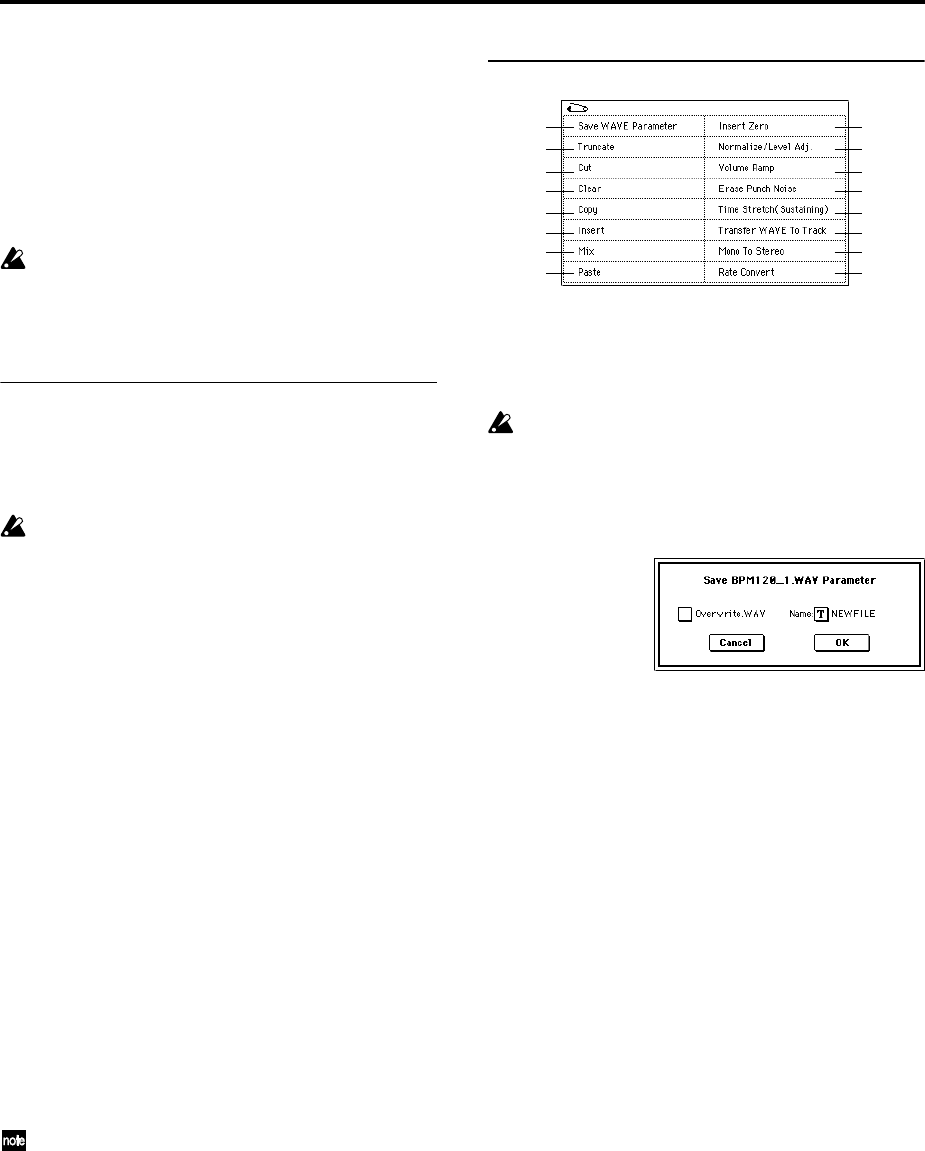
46
address will move by one pixel.) In the vertical axis, you can
zoom-in through a range of 1x (full range display) to 512x
(in the case of stereo, 1024x).
Zoom-in/out will start at the most recent address selected
for “Edit Range Start,” “Edit Range End,” “LoopS,” or
“End” point. If after zooming-in/out you reselect the “Edit
Range Start,” “Edit Range End,” “LoopS,” or “End” point,
the displayed area will change so that the selected point is
visible.)
At low zoom ratios (1x or less), the waveform shown in
the waveform display may be slightly different before
and after editing, but this will not affect the playback.
In this case, raising the zoom ratio will cause the wave-
form to be displayed correctly.
0–6b: WAVE Parameter
Here you can set the “Loop On/Off,” “Loop S,” and “End”
setting of the WAVE file. If you edit any of these settings,
you must execute the page menu command “Save WAVE
Parameter.”
“Loop On/Off,” “Loop S,” and “End” settings are used
only when the WAVE file is loaded into sample mem-
ory (RAM) in Sampling mode (Disk mode 0–1: Load,
26) Load .WAV ☞PG p.164). These settings are not used
when playing an audio track or when playing a WAVE
file in the 0–1: Load page. In the waveform display of
the Edit WAVE page, you can only view the “Loop On/
Off,” “Loop S,” and “End” addresses. (☞p.45 “WAVE
file waveform display”)
Loop On/Off [Off, On]
Specifies whether the WAVE file waveform will be looped.
On (checked): The waveform will play repeatedly from
“LoopS” to the end; i.e., “sample start” → “sample end” →
“LoopS” → “sample end” → “LoopS” ...
Off (unchecked): The waveform will play once from “sam-
ple start” → “sample end”; i.e., one-shot playback.
If you change “Loop On/Off” from Off to On, the “sample
start” and “sample end” addresses will be set as the initial
values of “LoopS” and “End.”
LoopS [0000000...]
End [0000000...]
These parameters specify the loop start address and end
address that will be used when playing the WAVE file.
These points are valid only if Loop is on. The numerical val-
ues are sample addresses. The addresses you specify here
are shown as vertical lines in the “WAVE file waveform dis-
play.”
If “Loop On/Off” is On, the “LoopS” and “End” values
will be the initial values of “Edit Range Start” and “Edit
Range End”; when you press the SAMPLING [START/
STOP] key, only the region between “LoopS” and
“End” will play back. If you want to check the looping,
load the WAVE file into sample memory (RAM) and
check it in Sampling mode. If the size of the WAVE file
exceeds the capacity of sample memory (RAM) so that
you are unable to load it, use the page menu command
“Truncate” or “Cut” to extract the “LoopS” and “End”
region and create a new WAVE file that is small enough
to load.
▼0–6: Page menu command
0–6A: Save WAVE Parameter
This command saves the state of the WAVE parameters (0–
6b: WAVE Parameter) to the WAVE file. Execute this func-
tion after you have edited the WAVE parameters.
The only WAVE parameters that are saved are “Loop
On/Off,” “LoopS,” and “End.” These settings are valid
only when the WAVE file is loaded into a device (e.g.,
application) that uses these parameters.
1 After editing the WAVE parameters, select “Save WAVE
Parameter” to open the dialog box.
2 If you want to overwrite the original WAVE file, check
“Overwrite.WAV.” If you want to create a new WAVE
file, don’t check this. If this is not checked, a new WAVE
file will be created in the same directory as the original
file. Normally you will execute this without checking
“Overwrite.WAV.”
3 If you are creating a new WAVE file, use “Name” to spec-
ify a name for the new WAVE.
4 To save the file, press the OK button. If you decide not to
save, press the Cancel button.
0–6B: Truncate
This command deletes the unwanted data that is outside the
“Edit Range Start” – “Edit Range End” region (0–6a). This is
the same function as the Sampling mode, Sampling P1: Sam-
ple Edit page menu command “Truncate”; here performed
on a WAVE file. (For details on the function and procedure,
☞PG p.101 “1–1A: Truncate”).
The “Overwrite.WAV” and “Name” fields in the dialog box
are as explained in “0–6A: Save WAVE Parameter” steps
2
and
3.
0–6C: Cut
This command deletes the data from the “Edit Range Start”
– “Edit Range End” region (0–6a). Subsequent data will be
moved forward. This is the same function as the Sampling
mode, Sampling P1: Sample Edit page menu command
“Cut”; here performed on a WAVE file. (For details on the
function and procedure, ☞PG p.102 “1–1B: Cut”).
The “Overwrite.WAV” and “Name” fields in the dialog box
are as explained in “0–6A: Save WAVE Parameter” steps
2
and
3.
0–6A
0–6B
0–6C
0–6D
0–6E
0–6F
0–6G
0–6H
0–6I
0–6J
0–6K
0–6L
0–6M
0–6N
0–6O
0–6P


















